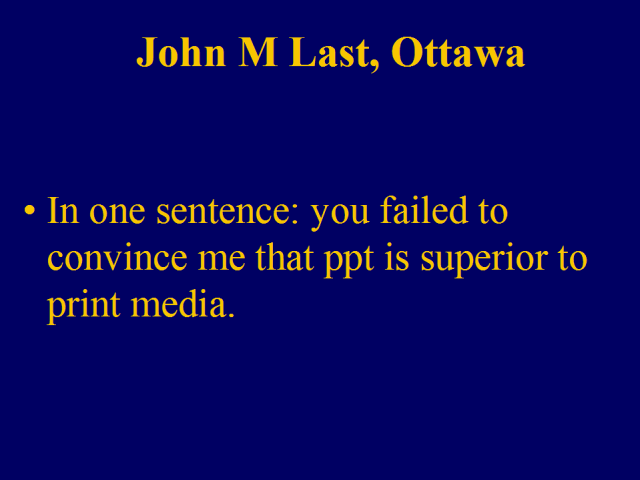John M Last is an author of the «Fouling and Cleansing our Nest;
Human-induced Ecological Determinants of Disease» Supercourse’s lecture.
I'm not knocking the Supercourse, I think it has achieved and continues
to achieve great things. But as a lifelong bookworm and habitue of dusty,
musty library stacks, and a voracious reader who reads anywhere and
everywhere, I'm constantly conscious of places where I read that a computer,
even a laptop, probably even a palm pilot, can't go or would have
intolerable difficulty going.
Electronically produced and transmitted educational material has the most
obvious advantages of speed and efficient worldwide dissemination and
elimination of postal charges, etc. (Although the capital and running costs
of computers and peripherals are probably higher).
PowerPoint slides and the accompanying oral commentary don't contain as much
information as a printed paper, which if well-written, well-edited and
well-presented, can be packed with information. It's easier and much faster
for the eye-brain linkage to scan through a few printed pages than to scroll
through multiple computer screens. It's easier on the eyes too, to read
print than to read computer screens, and we can read printed journals just
about anywhere, whereas computer screens can't always go with us - to bed,
to the bus or subway. Printed journals can be permanently archived (even if
not printed on acid-free paper). The lifetime of electronic archives is
unknown, but it seems unlikely they could survive at least 100 years or be
useful for that long unless very efficiently indexed. If electronically
transmitted scientific information is useful or original, its serious users
download and print it -- and often encounter formatting problems,
missing segments of material such as figures and tables, to say nothing of
the wasteful use of paper, polluting printers, etc.
The simple truth is that both electronicsignals and print media have their
uses and their place in the overall scheme of things. It's a rather empty
and futile exercise to say that one is "better than" the other.
